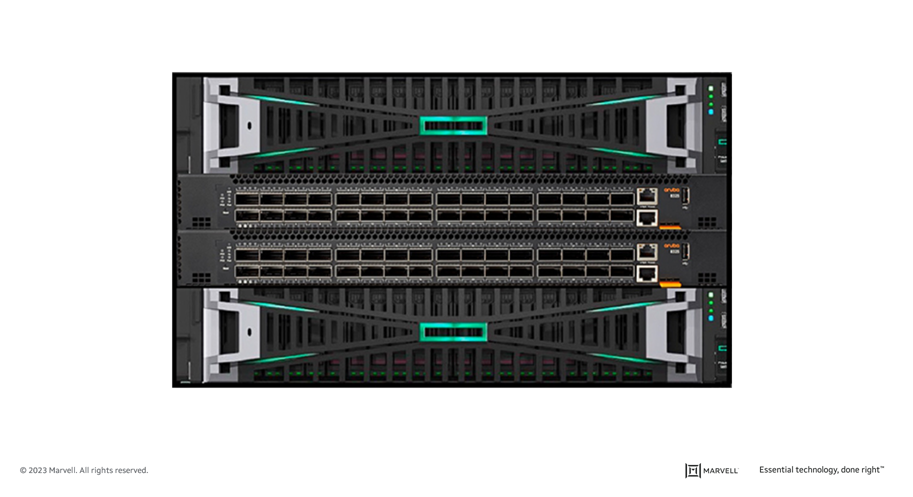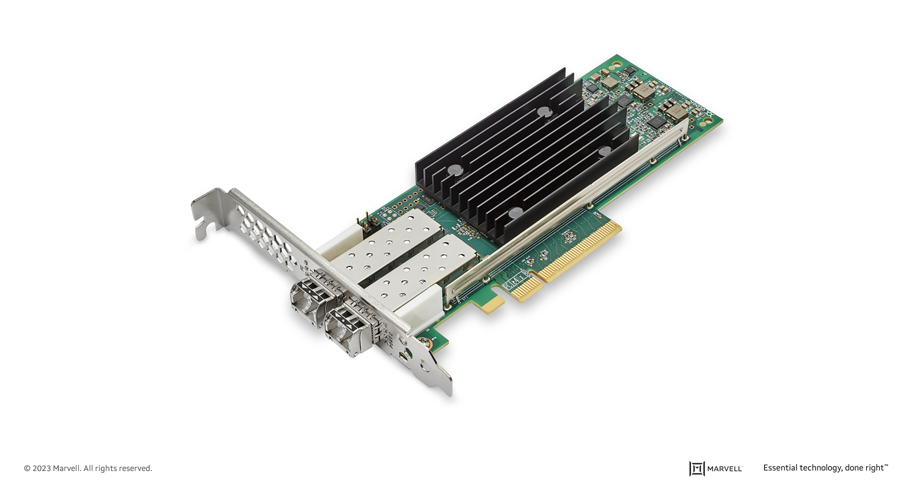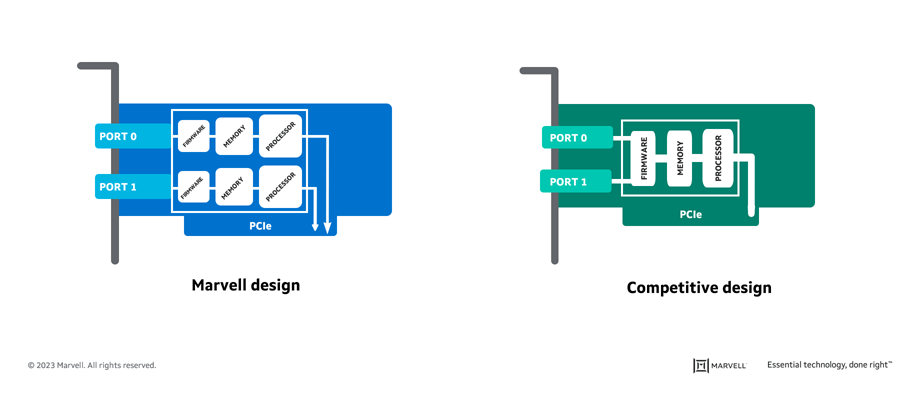- PRODUCTS
- COMPANY
- SUPPORT
- PRODUCTS
- BY TYPE
- BY MARKET
- COMPANY
- SUPPORT
FC-NVMe Goes Mainstream for Next-Generation Block Storage from HPE
While Fibre Channel (FC) has been around for a couple of decades now, the Fibre Channel industry continues to develop the technology in ways that keep it in the forefront of the data center for shared storage connectivity. Always a reliable technology, continued innovations in performance, security and manageability have made Fibre Channel I/O the go-to connectivity option for business-critical applications that leverage the most advanced shared storage arrays.
A recent development that highlights the progress and significance of Fibre Channel is Hewlett Packard Enterprise’s (HPE) recent announcement of their latest offering in their Storage as a Service (SaaS) lineup with 32Gb Fibre Channel connectivity. HPE GreenLake for Block Storage MP powered by HPE Alletra Storage MP hardware features a next-generation platform connected to the storage area network (SAN) using either traditional SCSI-based FC or NVMe over FC connectivity. This innovative solution not only provides customers with highly scalable capabilities but also delivers cloud-like management, allowing HPE customers to consume block storage any way they desire – own and manage, outsource management, or consume on demand.
 HPE GreenLake for Block Storage powered by Alletra Storage MP
HPE GreenLake for Block Storage powered by Alletra Storage MP
At launch, HPE is providing FC connectivity for this storage system to the host servers and supporting both FC-SCSI and native FC-NVMe. HPE plans to provide additional connectivity options in the future, but the fact they prioritized FC connectivity speaks volumes of the customer demand for mature, reliable, and low latency FC technology.
Marvell is proud to be the provider of the quad-port FC target host bus adapters (HBAs) in the HPE Alletra Storage MP hardware. Based on Marvell’s QLE2800 series Fibre Channel technology, the target adapter utilizes Marvell® QLogic® unique port isolated architecture. Marvell QLogic QLE2800 series HBAs are capable of delivering up to 64GFC bandwidth and support concurrent FC-SCSI and FC-NVMe communications along with a list of additional capabilities that HPE can potentially leverage in the future. These include support for virtual machine identification (VM-ID), automatic congestion management using Fabric Performance Impact Notifications (FPIN) and enhanced security with encrypted data in flight (EDiF).
 Marvell® QLogic® 2800 Series Fibre Channel Adapter
Marvell® QLogic® 2800 Series Fibre Channel Adapter
Port isolation architecture is unique to Marvell QLogic HBAs today. In the early days of FC, multi-port adapters were all designed with isolated ports to ensure predictable and reliable per-port performance. A few years back, other manufacturers changed their architecture to utilize a large processor and memory complex servicing all adapter ports apparently to simplify ASIC design and reduce manufacturing costs. Marvell QLogic HBA design stayed the course and utilizes individual processor, memory, and driver resources for each port on the adapter. This is critical in an enterprise array target adapter to deliver predictable and deterministic per-port performance.

One capability in FC that makes it ideal for next-generation NVMe-based storage arrays is the fact that FC can easily support concurrent SCSI or NVMe communications. From day one, FC has been a hardware offload technology. This means the I/O adapter in the host or target array manages the I/O processing with no support from the host system. Because of this, FC adapter firmware and drivers can seamlessly handle both SCSI and NVMe commands, imbed them into the FC frames for transmission and intelligently determine which protocol to send to which device in the SAN. Marvell QLogic is unique in that it uses a unified driver that supports both FC-SCSI and FC-NVMe, so no host driver changes are required when introducing NVMe-based storage to an existing FC SAN environment.
Other transport technologies like Ethernet do not offload the I/O and this greatly complicates the ability to mix the SCSI and NVMe protocols on the same transport. There currently is no intelligent way for an Ethernet NIC to determine what protocol to send to a specific device which makes concurrent iSCSI and NVMe over TCP problematic.
Additional capabilities in QLogic Fibre Channel technology include support for virtual machine ID (VM-ID) and fabric performance impact notification (FPIN). VM-ID imbeds the virtual machine ID that created the I/O request, which helps identify workloads that may be using large amounts of bandwidth. This helps storage administrators address the “noisy neighbor” effect that can happen in virtual server environments. To help automate identification and remediation of SAN congestion issues, FPIN signals can be transmitted between the I/O devices and the FC switches. I/O driver and firmware can then take action to throttle I/O traffic until congestion is reduced or fail over I/O transmissions to an alternate path. For customers who desire all data to be encrypted for extra security, Marvell QLogic 2800 series adapters can support data encryption end to end in the FC fabric as well.
The bottom line is that storage vendors like HPE who are delivering next-generation NVMe array technology are leading with FC connectivity for good reasons. The decision is grounded in the fact that FC remains the most mature, secure, reliable, and high-performance option for supporting NVMe-based arrays alongside legacy SCSI-based solutions. FC technology is rock solid and we at Marvell are extremely proud that HPE has selected Marvell QLogic technology for their latest industry-leading NVMe storage solution, HPE GreenLake for Block Storage powered by Alletra Storage MP. Marvell QLogic HBA technology is also available from HPE for HPE ProLiant servers, including the HPE SN1100Q, HPE SN1610Q and HPE SN1700Q Fibre Channel adapters. This highlights the continued collaboration between Marvell and HPE to deliver robust and high-performance FC solutions for various infrastructure needs. We are thrilled to contribute to HPE's industry-leading storage offerings and to play a role in advancing the adoption of NVMe technology in the market.
For more information on Marvell QLogic technology, visit www.marvell.com/qlogic. If you have questions, reach out to our Fibre Channel team at oem-customer-solutions@marvell.com.
Tags: Data Center, encrypted data in flight, Ethernet NIC, FC Technology, FC-, FC-SCSI, Fibre Channel, Fibre Channel connectivity, FPIN, NVMe communications, NVMe over FC connectivity, NVMe storage solution, NVMe-based arrays, SCSI-based solutions, shared storage arrays, storage connectivity, virtual machine identification
Recent Posts
- Marvell Wins LEAP Award for 1.6T LPO Optical Chipset
- Co-packaged Optics: Powering the Next Wave of AI Data Center Innovation
- AI Scale Up Goes for Distance with 9-meter 800G AEC from Infraeo and Marvell
- Faster, Farther and Going Optical: How PCIe Is Accelerating the AI Revolution
- Marvell Wins Leading EDGE Award for Ara 1.6T Optical DSP
Archives
Categories
- 5G (10)
- AI (42)
- Cloud (17)
- Coherent DSP (11)
- Company News (102)
- Custom Silicon Solutions (8)
- Data Center (65)
- Data Processing Units (21)
- Enterprise (24)
- ESG (10)
- Ethernet Adapters and Controllers (11)
- Ethernet PHYs (3)
- Ethernet Switching (41)
- Fibre Channel (10)
- Marvell Government Solutions (2)
- Networking (42)
- Optical Modules (18)
- Security (6)
- Server Connectivity (32)
- SSD Controllers (5)
- Storage (22)
- Storage Accelerators (2)
- What Makes Marvell (45)
Copyright © 2025 Marvell, All rights reserved.
- Terms of Use
- Privacy Policy
- Contact


